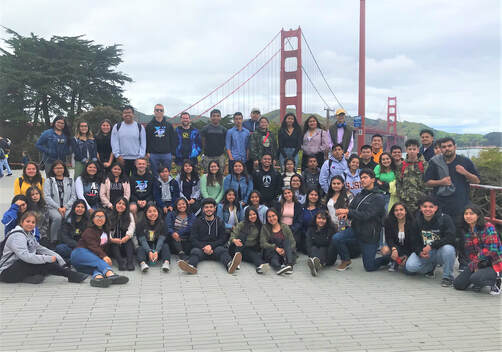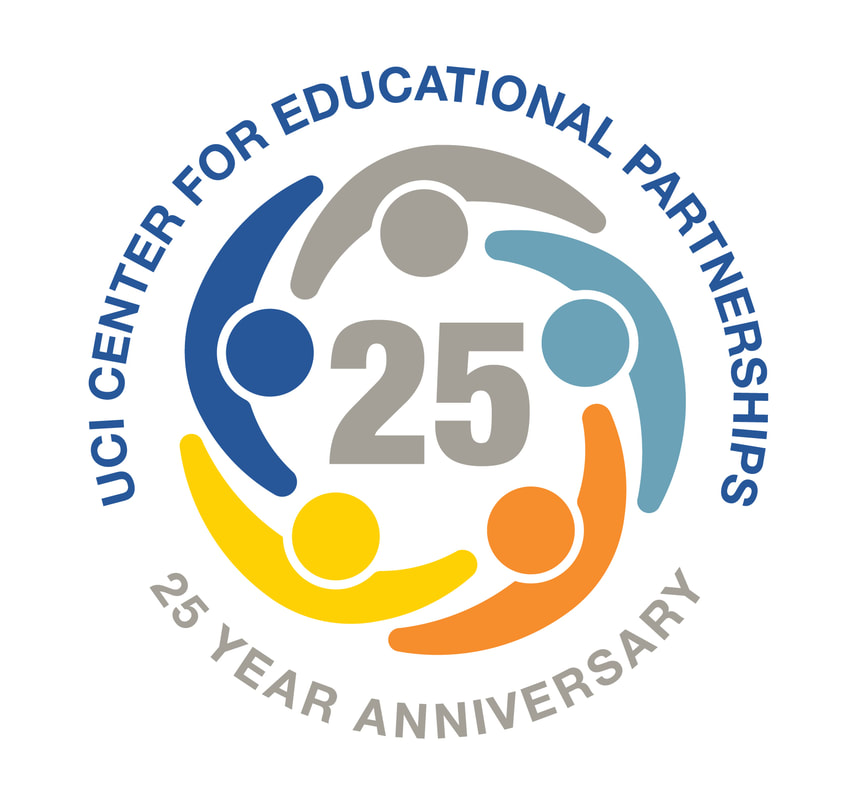CHANGING COLLEGE TRAJECTORIES
|
In 2010, the California Department of Education labeled Valley High School in Santa Ana as “persistently low-achieving.” With this distinction, Valley faced swaths of potential reform, including permanent closure.
“By any measure – graduation rate, attendance, expulsion rates – any way you looked at it, Valley was the pits,” said Patrick Yrarrazaval-Correa, who became principal of Valley in 2011. “The kids knew it, the teachers knew it, and the district knew it.” One afternoon, “Mr. Patrick,” as he’s affectionately known, called Stephanie Reyes-Tuccio, assistant vice chancellor, educational partnerships,and said “I have an idea, will you meet me for lunch and we can make it happen?" Over tacos, Yrarrazaval-Correa sketched a plan on the back of a napkin. |
“We brainstormed how we could take the promising students coming out of middle school and give them an elite preparatory academy experience,” Reyes-Tuccio recalled. “We called it EAOP on steroids.
“After years of effective partnering with Mr. Patrick, all it took was a single lunch.”
The duo conceptualized the Anteater Academy – a strategic learning community that increases the competitive admissions eligibility of its program participants, nearly all of whom are underrepresented minorities and first-generation college students. In the Anteater Academy, a cohort of Valley students – typically 72 per grade – enroll in honors or AP classes in four subjects each year: Math, Science, English and History. The cohort stays mostly consistent throughout the four years, as do the teachers.
“This was controversial because we mandated the schedule for teachers and students. We believed the relationships between students and teachers would be critical and had to be maintained and that if we knew what would make students academically competitive, then those would be the classes they would take,” Reyes-Tuccio said.
“After years of effective partnering with Mr. Patrick, all it took was a single lunch.”
The duo conceptualized the Anteater Academy – a strategic learning community that increases the competitive admissions eligibility of its program participants, nearly all of whom are underrepresented minorities and first-generation college students. In the Anteater Academy, a cohort of Valley students – typically 72 per grade – enroll in honors or AP classes in four subjects each year: Math, Science, English and History. The cohort stays mostly consistent throughout the four years, as do the teachers.
“This was controversial because we mandated the schedule for teachers and students. We believed the relationships between students and teachers would be critical and had to be maintained and that if we knew what would make students academically competitive, then those would be the classes they would take,” Reyes-Tuccio said.
|
“The Anteater Academy is effective and unique for a few reasons,” explained Matthew Conover, director of the Academy since its inception and chair of Valley High School’s math department. “Students have the same classes with each other, so they are more willing to engage with each other academically, to ask each other for help, and to participate in class – it makes them more effective learners.
“Additionally, the teachers follow the kids,” Conover continued. “Every teacher teaches two grades within the Academy, so we understand the students’ progression. Sometimes it’s less about the mastery of a particular subject and more about how the kids progress throughout the years – and it makes us better able to help them develop.” |
The numbers speak for themselves – 91 percent of Anteater Academy students all-time have been admitted to a four-year college; including Harvard, Stanford, Columbia, USC, Notre Dame, NYU, Dartmouth, and all nine UC campuses. More than 60 percent of Anteater Academy students have been admitted to a UC or equally competitive university.
/
We sent letters to the Valley High School parents and UCI students inviting them to be a part of something that recognized their potential. We envisioned a campus filled with students in their college sweatshirts transforming Valley into a place students believed they were headed to a bright future.
Assistant Vice Chancellor, Educational Partnerships |
There’s also been an “Anteater Academy Effect,” in which the college-going nature and spirit has bled out from the Academy to the rest of Valley High School students.
CFEP helps to keep the Anteater Academy and its students on the cutting-edge of the college admissions process. CFEP identifies what classes the Anteater Academy should offer to its students, what extracurricular activities students should pursue, what programs would align with a student’s preferred major, and more. “Simply put, UCI helps us make the kids competitive,” Conover said. CFEP also hosts a student coordinator at the Anteater Academy. This individual gives presentations in class, answers questions about extracurricular activities, meets one-on-one with struggling students, and helps with college and financial aid applications. The placement of this student dates back to the initial vision from the taco lunch between Yrarrazaval-Correa and Reyes-Tuccio. |
“We sent letters to the Valley High School parents and UCI students inviting them to be a part of something that recognized their potential and explained the benefits they would receive, but also the commitment that would be required,” Reyes-Tuccio said. “We envisioned a campus filled with students in their college sweatshirts, which UCI provided, transforming Valley into a place students believed they were headed to a bright future. Mr. Patrick’s plan would change Valley’s culture and the college-going trajectories of its high school students."
Last but not least, UCI hosts a field trip for Anteater Academy students. In fact, all nine UC campuses host the Anteater Cohort. At UCI, Cristina Flores, assistant director of CFEP’s Early Access Outreach Program, presents to the students on what it means to be competitive at a university with the caliber of UCI.
“The kids have heard it since they were freshmen – from teachers, myself, and Valley staff,” Conover said. “But hearing it from a UCI admissions person, on the actual campus, makes a big impact on the kids.”
While Yrarrazaval-Correa was the principal to create and implement the Anteater Academy, he recognizes the teachers and staff who did the heavy lifting and carried forth the mission. Chief among them: Jim Fitch, Olivier Cazalis, and Jeff Hruby, co-director of the Irvine Math Project.
“There were a lot of people in my leadership group and among my advisors who had a vision of how to make Valley a more attractive and better-performing school,” he said. “There was some initial pushback to the idea, but once everyone started seeing the fruits of labor, it was hard to argue against it. Everything declined following the introduction of this – drug use, fights, dropouts, even graffiti, were all down.
“It was radical at the time, but now it’s one of those things that everyone looks back on and says ‘What a good idea!’”
Last but not least, UCI hosts a field trip for Anteater Academy students. In fact, all nine UC campuses host the Anteater Cohort. At UCI, Cristina Flores, assistant director of CFEP’s Early Access Outreach Program, presents to the students on what it means to be competitive at a university with the caliber of UCI.
“The kids have heard it since they were freshmen – from teachers, myself, and Valley staff,” Conover said. “But hearing it from a UCI admissions person, on the actual campus, makes a big impact on the kids.”
While Yrarrazaval-Correa was the principal to create and implement the Anteater Academy, he recognizes the teachers and staff who did the heavy lifting and carried forth the mission. Chief among them: Jim Fitch, Olivier Cazalis, and Jeff Hruby, co-director of the Irvine Math Project.
“There were a lot of people in my leadership group and among my advisors who had a vision of how to make Valley a more attractive and better-performing school,” he said. “There was some initial pushback to the idea, but once everyone started seeing the fruits of labor, it was hard to argue against it. Everything declined following the introduction of this – drug use, fights, dropouts, even graffiti, were all down.
“It was radical at the time, but now it’s one of those things that everyone looks back on and says ‘What a good idea!’”
The preceding story is part of the "CFEP: 25 Years of Impact" series, honoring the people, programs and partnerships that have helped impact millions of students, teachers and families over the past quarter century. View the entire series here.





